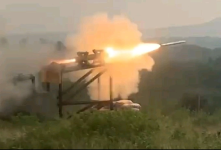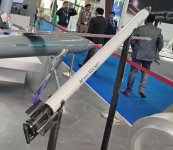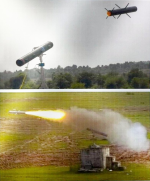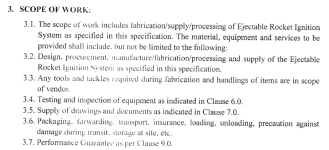Is there any info about VEM tech Vismai Manpads at Aero India VEM Tech to unveil Advanced Medium Combat Aircraft at Aero India show today
You are using an out of date browser. It may not display this or other websites correctly.
You should upgrade or use an alternative browser.
You should upgrade or use an alternative browser.
MoD inks Rs 2,500 crore contracts for NAMIS Tracked version of anti-tank weapon platform & 5,000 Light Vehicles
Posted On: 27 MAR 2025 5:14PM by PIB DelhiMinistry of Defence has signed a contract with Armoured Vehicle Nigam Limited for the procurement of Nag Missile System (NAMIS) Tracked version of anti-tank weapon platform and Force Motors Ltd & Mahindra & Mahindra Ltd for around 5,000 Light Vehicles for the Armed Forces at a total cost of around Rs 2,500 crore. These contracts under Buy (Indian-Indigenously Designed Developed and Manufactured) category were inked in the presence of Defence Secretary Shri Rajesh Kumar Singh in New Delhi on March 27, 2025.
NAMIS (Tr) weapon system
The total cost of contract for the procurement of NAMIS(Tr) weapon system, developed by Defence Research & Development Laboratory of DRDO, is Rs 1,801.34 crore. It marks a significant milestone in the modernisation of the anti-tank capability of Mechanised Infantry, enhancing Indian Army’s operational readiness across a varied spectrum of operations.
NAMIS (Tr) is one of the most sophisticated anti-tank weapon system against enemy armour with fire-and-forget anti-tank missile and sighting system for enhanced firepower and lethality. The weapon system is set to transform the conduct of mechanised operation and offer operational advantage against the adversary.
Light Vehicles
These modern vehicles are designed as per contemporary vehicle technology with enhanced engine power to cater to a payload of 800 kgs. It will provide mobility to the Armed Forces in all types of terrain and operational conditions.
Both procurements will enhance indigenisation and national defence equipment manufacturing capabilities. The projects have immense potential of direct and indirect employment generation by encouraging the MSME sector through components’ manufacturing. The procurement marks a pivotal step towards modernising the country’s defence infrastructure and empowering indigenous industries, in line with the vision of Aatmanirbhar Bharat.

Force Motors Lands Major Defence Contract for Nearly 3,000 Vehicles | Autocar Professional
Force Motors Limited secures a contract to supply 2,978 Gurkha 4X4 vehicles to the Indian Defence Forces, supporting military logistics with a phased delivery plan over three years for deployment across various units.
A large follow-on order for Nag/Mk2 ATGMs should be happening soon now that they've ordered the NAMIS/BMP-2 carriers.MoD inks Rs 2,500 crore contracts for NAMIS Tracked version of anti-tank weapon platform & 5,000 Light Vehicles
Posted On: 27 MAR 2025 5:14PM by PIB Delhi
Ministry of Defence has signed a contract with Armoured Vehicle Nigam Limited for the procurement of Nag Missile System (NAMIS) Tracked version of anti-tank weapon platform and Force Motors Ltd & Mahindra & Mahindra Ltd for around 5,000 Light Vehicles for the Armed Forces at a total cost of around Rs 2,500 crore. These contracts under Buy (Indian-Indigenously Designed Developed and Manufactured) category were inked in the presence of Defence Secretary Shri Rajesh Kumar Singh in New Delhi on March 27, 2025.
NAMIS (Tr) weapon system
The total cost of contract for the procurement of NAMIS(Tr) weapon system, developed by Defence Research & Development Laboratory of DRDO, is Rs 1,801.34 crore. It marks a significant milestone in the modernisation of the anti-tank capability of Mechanised Infantry, enhancing Indian Army’s operational readiness across a varied spectrum of operations.
NAMIS (Tr) is one of the most sophisticated anti-tank weapon system against enemy armour with fire-and-forget anti-tank missile and sighting system for enhanced firepower and lethality. The weapon system is set to transform the conduct of mechanised operation and offer operational advantage against the adversary.
Light Vehicles
These modern vehicles are designed as per contemporary vehicle technology with enhanced engine power to cater to a payload of 800 kgs. It will provide mobility to the Armed Forces in all types of terrain and operational conditions.
Both procurements will enhance indigenisation and national defence equipment manufacturing capabilities. The projects have immense potential of direct and indirect employment generation by encouraging the MSME sector through components’ manufacturing. The procurement marks a pivotal step towards modernising the country’s defence infrastructure and empowering indigenous industries, in line with the vision of Aatmanirbhar Bharat.
People wondering about the pathetic order size of NAMIS system are looking at things from the wrong perspective. If you guys ever noticed the MoD press releases, this was posted:

This just means that NAMIS order was placed with whatever capital was left over, thats why the wierd numbers. This also shows that bureaucratic laziness is the reason why a lot of products that have completed their development cycle are not getting orders.

This just means that NAMIS order was placed with whatever capital was left over, thats why the wierd numbers. This also shows that bureaucratic laziness is the reason why a lot of products that have completed their development cycle are not getting orders.
These order files move for 18-30 months from AoN to CCS. Not random numbers.This just means that NAMIS order was placed with whatever capital was left over, thats why the wierd numbers. This also shows that bureaucratic laziness is the reason why a lot of products that have completed their development cycle are not getting orders.
These order files move for 18-30 months from AoN to CCS. Not random numbers.
Nah, i think you are putting too much faith the entire babu file shifting process. All this can be expedited or slowed on whims of people in power. NAMIS as a product had completed its trials long back. It has been stuck in this limbo for longer than a couple of years. Their must have been a priority list of products ready for contract signing. I'm guessing that a babu was given an explicit order to use up this years capital allocation. NAMIS might have been the last item on that list upto which he could stretch this years entire budget.
Doesn't make any sense whatsoever. The order numbers are not decided by just bureaucrats there are several other entities present. Especially before moving the files to the CCS there are several permissions that are needed because they need to show clarity about the money required, numbers ordered, period of delivery, etc. None of these things can be done last minute especially with the speed things work and it probably takes more than a FY. Like @marich01 mentioned.I'm guessing that a babu was given an explicit order to use up this years capital allocation. NAMIS might have been the last item on that list upto which he could stretch this years entire budget.
Services decide on quality during their request for AoN to DAC. Then it's a few year process.People wondering about the pathetic order size of NAMIS system are looking at things from the wrong perspective. If you guys ever noticed the MoD press releases, this was posted:
View attachment 42085
This just means that NAMIS order was placed with whatever capital was left over, thats why the wierd numbers. This also shows that bureaucratic laziness is the reason why a lot of products that have completed their development cycle are not getting orders.
Bureaucrats can adjust the advance payment and schedule which is agreed upon during the contract. That's the least they can do to reach political directives like above to utilise full capital budget.
report about new test site in AP
There is also no other update on the Junput site except this answer in Rajya Sabha , probably will remain inactive for few years now like before
It is not yet clear when the construction of the missile test center in Nagayalanka, Krishna district, Andhra Pradesh, will begin.
This project, which was sanctioned to Andhra Pradesh fourteen years ago, has been delayed in taking shape. At one stage, there was even talk of moving it to Gujarat.
However, doubts that the project would be moved away from here were dispelled when the Union Cabinet Committee on Security, chaired by Prime Minister Modi, made it clear six months ago that the project would be built in AP.
The decision that the missile testing center will be built in AP came after the committee meeting. However, no one at the state level has been saying exactly when the foundation stone of the project will be laid for almost six months. On the other hand, defense sources say that they cannot say anything about it.
What is the actual project?
Considering the need for the construction of another missile testing center in addition to Balasore in Odisha in view of the country's defense needs, the central government allocated this project to Andhra Pradesh in 2011. At that time, the area of Gullalamoda village in Nagayalanka mandal in Diviseema, Krishna district was identified as a suitable area for the construction of this center.
It was decided that this village would be suitable for missile launches, as it is a coastal area and there are no settlements within an eight-kilometer radius.
It was decided at the time that the fragments from the missile tests would fall into the ocean, posing no danger to anyone, and there would be no damage to the environment.
In this context, in 2012, DRDO requested the then joint AP government to allocate land for this project.
However, due to the partition movements in the then united Andhra Pradesh, the rulers did not pay attention to the lands. As a result, there was no movement on this project for almost five years.
Land allocation in 2017
After the bifurcation of the united Andhra Pradesh, in 2017, during the then TDP government, 381.61 acres of land were allocated to DRDO (Defense Research and Development Organization) for the project.
However, objections were raised as there were mangrove forests in the area where these lands were allocated. As a result, the then government handed over 381.61 acres of revenue land in the Ganapeshwaram area to the Forest Department in exchange for those lands and issued G.O. 1352, thus resolving the land issue.
Then, in 2017, the first phase of permissions were received from the Union Ministry of Forests and Environment.
An exemption from the CRZ was also obtained in 2018. In 2019, the second phase of permissions were obtained from the Ministry of Environment, and in 2020-21, the DRDO took possession of the site and constructed a fence, an entrance gate, and a building.
Again, clarity came six months ago.
There has been no progress on the project for almost three years since the construction of the fence and building. At one point, there was even talk that the project would be moved to Gujarat.
However, in October 2024, the Union Cabinet Committee on Security, chaired by Prime Minister Narendra Modi, approved the establishment of a missile launch test base at Gullamoda in Nagayalanka mandal, making it clear that it will remain here.
We tried during our rule: YSRCP
Meanwhile, Simhadri Ramesh Babu, who was the YSRCP MLA for the Avanigadda constituency for those five years, spoke to the BBC about the campaign that the project would be delayed and moved between 2019-24 during the YSRCP regime.
He said that the DRDO land was handed over only after the YSRCP government came to power, and the construction of the building was completed in 2021. He said that he and MP Mithun Reddy had repeatedly appealed to the relevant defense officials to start the work on the project. Ramesh Babu said that the reasons are unknown, but the work has not started.
He said that no matter whose term the work is done under, it should be good for the area.
Key missile tests are here.
Once the construction of this center is complete, key surface-to-air missile tests will be conducted from here.
They also test many types of missiles developed by DRDO.
In addition to ballistic missiles that target long-range targets, cruise missiles and anti-missile systems will be tested.
Missile guidance systems, propulsion systems, and many key technical departments will be set up here.
Computer-based simulation systems are also used to analyze data when testing missiles.
To this extent, units and blocks related to testing requirements are to be built here. Meanwhile, the BBC contacted current Defense Advisor Satish Reddy, who visited here in 2021 as the Chairman of DRDO and inspected it.
He said that he will speak in detail once there is clarity on the start of the work, and that once the construction of the missile test center is completed, the entire look of the area will change.
Will there be a foundation stone laying ceremony during Modi's Amaravati tour?
In fact, Machilipatnam RDO Swathi told the BBC that earlier this year, during Prime Minister Modi's visit to Visakhapatnam in January, all arrangements were made to virtually lay the foundation stone for this center, but it was canceled at the last minute.
The RDO said that they received information that since it was a very prestigious project, he himself would come and lay the foundation stone, which is why it was postponed.
The RDO said that they are still not clear on whether Modi will come here at the same time if he comes for the Amaravati reconstruction work this month or will he lay the foundation stone virtually from there.
Diviseema Development: Mandali Buddhaprasad
Avanigadda MLA Mandali Buddhaprasad told the BBC that the Diviseema region will develop greatly with this project.
He said that they were concerned about the publicity that the project would be moved, but since it became clear last October that it would be established here, they are waiting to see when the groundbreaking ceremony will be held.
Machilipatnam MP Vallabhaneni Balashouri told the BBC that there is still no clarity on when the work will begin.
Balashouri said that with the arrival of the project, this area will develop rapidly and many people will gain livelihoods.
Colonel Sameer Sharma told the BBC that no information related to the project can be given to the media at this time.
Meanwhile, officials from Visakhapatnam's DRDO (Defense Research and Development Organization) and NSTL (Naval Science and Technological Laboratory) were not willing to speak on the matter.
There is also no other update on the Junput site except this answer in Rajya Sabha , probably will remain inactive for few years now like before
Probably has a 2 way datalink for man-in-the-loop guidance.
What damage that tiny warhead can do with all those advance technologiaProbably has a 2 way datalink for man-in-the-loop guidance.
2 way datalink & dual band TM antenna system is likely mandatory for every glide weapon system RCI make, else you would lose control over it aka it makes no sense to use such a weapon.Probably has a 2 way datalink for man-in-the-loop guidance.
Anyway, some interesting things are happening which we are yet to grasp properly. Lets see.
Like the spice , multiple can be & will be used against a specific target. One su30 alone can launch probably 20 of those. Effect is extensive scattered damage compared to one large crater. Far more effective.What damage that tiny warhead can do with all those advance technologia
The initial version of SAAW was GPS/INS only. I meant it in that context. We are yet to see a datalink pod from DRDO though.2 way datalink & dual band TM antenna system is likely mandatory for every glide weapon system RCI make, else you would lose control over it aka it makes no sense to use such a weapon.
Initial mk1 versions much like the ulpgm case are very basic in nature. On the TARA LRGB scale where the article payload is much larger than saaw , the datalink with antenna and possibly even seeker would be incorporated as the system mature.The initial version of SAAW was GPS/INS only. I meant it in that context. We are yet to see a datalink pod from DRDO though.
Tara will likely use the same laser seeker from the PG-HSLD. After all, it is an evolved version of the latter.Initial mk1 versions much like the ulpgm case are very basic in nature. On the TARA LRGB scale where the article payload is much larger than saaw , the datalink with antenna and possibly even seeker would be incorporated as the system mature.






